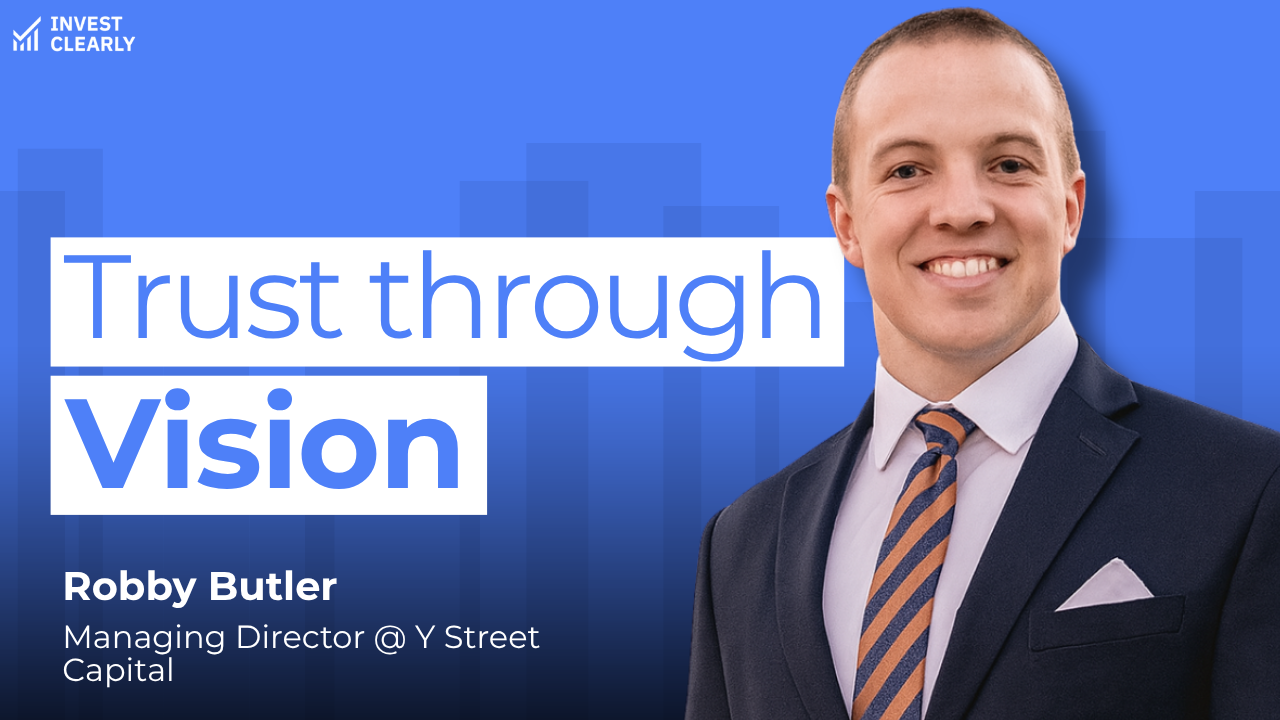
AI, Investor Trust, and Capital Calls with Robby Butler
Never miss an Invest Clearly Insights article
Subscribe to our newsletter today
In this conversation, Robby Butler of Y Street Capital discusses the intricacies of real estate development, emphasizing the importance of building trust with investors through education and transparency. He shares insights on the challenges of development, the balance between sales and education, and the role of AI in enhancing investor relations.
The discussion also touches on the evolving landscape of investor expectations and the need for greater transparency in the industry, particularly regarding accreditation and investor trust.
Robby Butler and Pat - Y Street Capital Podcast Interview
Opening Quote: I think accreditation is a myth that needs to die because how many developers have ripped people off for the last couple centuries? A lot of them. We brought on a builder partner and found out values are not aligned, and they said no. We thought you knew how to identify the right builder partner. We don't trust you anymore. We could talk for days about the frauds we've uncovered using AI.
[00:00:27] Intro: Investors and operators, welcome back to the Invest Clearly Podcast. In today's episode, we sit down with Robby Butler, managing director of Y Street Capital. His firm focuses on ground-up development in secondary markets with a long sales cycle and deeper-than-usual education process. We talk about how Robby builds trust through vision, why he shares past capital calls with new investors, and how AI is changing due diligence and deal transparency. He also explains why he encourages LPs to run their own AI analysis on Y Street and why the traditional accreditation model may be limiting investor access more than protecting it. Let's get into it.
[00:01:23] Pat: Cool. Robby, thank you very much for joining us. You and I have gotten to know each other throughout the history of Invest Clearly. I think you were one of the first people to find it. You got me on Victor's podcast. That's fantastic. Before we really hop into things, I'd love for you to introduce Y Street Capital as well as yourself, and then we'll jump into it.
[00:01:42] Robby Butler: Happy to. Y Street Capital was born in Canada before the pandemic as a group of entrepreneurs who said, "Look, we've all done deals in the U.S. and in Canada, and we want to come together and create an institutional-quality developer." That was pre-pandemic, and then we got through the pandemic. We're in about nine states now. We have about 14 projects in various stages of development. We are land developers at our core. We'll look opportunistically at just about anything, but at the end of the day, we're looking for something really unique that we can create typically from the ground up, which is probably the most challenging real estate product to hold trust from investors because you start with nothing and at some point you get a building. But that takes some patience. It takes some vision both from the entrepreneur side and from the investor side.
When I first learned about Invest Clearly, I said, "Yep, I see the need entirely," because how many developers have ripped people off for the last couple centuries? A lot of them. So I loved it. Because my background was in philanthropic fundraising before my real estate career, helping people to understand what their money was doing and where they can trust making their investments or their donations, I saw it immediately and said, "Pat and I are going to be great friends."
[00:03:02] Pat: Yeah. I would love to learn more about your trust through vision. I've spoken to many syndicators who have done development deals, and that ends up being some of their worst deals when they're moving from value-add to development, mainly because of the expectations of the investor. They go from maybe cashflow day one to, "Hey, it's been a long time since I've received a distribution from the start." How do you create that trust through vision and then how do you back it up?
[00:03:24] Robby Butler: Such a great question. My first answer is careful education—being so clear with people from the outset that this is a different type of deal. You're either at the entitlements phase or perhaps you're even further—we're buying it true raw and we're going to annex it into a county. You have to understand this is the value creation. They say development is the true value-add because you're starting with nothing, or sometimes less than nothing.
[00:03:55] Pat: Yeah.
[00:03:56] Robby Butler: Exactly. Free land and you're suddenly going to create some income stream off of it. But describing to them, "Okay, we're talking now, but are you okay if there's still no distribution in 2027? Okay, what about 2029 if it's a really big deal, a master plan community or something?" So that education piece can take a long time. I find our sales cycle to be sometimes six or nine months. Most value-add investors have 30 days to bring the investors in. You're already under contract and they've got to make a decision in 20 days, and they've got to wire on the 23rd so it gets there by the 30th or whatever. Ours is much longer, so that allows for a lot of education along the way and checking in and finding out what their real goals are and how we can be sure that this deal matches up.
[00:04:42] Pat: Sure. So that six to nine months, is that one specific deal? It's not, "Hey, they entered in on day one and then maybe they considered the third or fourth land deal in front of them," or is that just average across the board?
[00:04:53] Robby Butler: I would say average across the board. Great point though, that there are some deals where we can have that long of a timeline. We have an open-ended fund so they can show up nine months later and go, "Now I get it. I'm still interested." But there also are—there's a land deal as an example where we did the entitlements phase and now we're doing the horizontal phase. So they may have missed that first cycle and then they can get in on the next cycle, different deal metrics, but same underlying deal. So that does happen, but in general it's six to nine months. So they're going to miss two or three deals of ours just because they have to learn and they have to get comfortable with, "This is a growth product—you're not going to see that money again for sometimes years."
[00:05:33] Pat: Yeah, very interesting. I've been in corporate sales cycles that are six to nine months at the enterprise level, and there's a lot of pressure in there. I guess, off the top of your head, what is the balance of your repeat investors to new investors, and then do you see more repeat investors because they're familiar with that process versus, "Hey, I feel the pressure of always needing to get a new investor in the door"? You know what I mean? What's that look like for you guys?
[00:06:02] Robby Butler: That's a great question. When I think about the breadth—I believe the number is around 300 existing investors in our company right now—when I think about the breadth of them, I would say about 150 of them are repeats. People who have said, "Yep, I want to keep applying my capital to growth opportunities. I've got my value-add, I've got my core assets. I want to keep applying to growth opportunities." Sometimes when you have a person with ultra-high net worth and they're allocating once every month, that's a nice investor to know because you're going to see repeat investments simply because they have to continue making investments.
When it's a little bit more of your traditional retail LP, someone who's placing money, let's call it every quarter or maybe every six months, that person has got to be more methodical. They've got to learn more. So we do see a fairly consistent level of new investors, people who hear us from our podcast or they get a referral from someone. But you always have those just because of the nature of our business not being very fast—development is very slow. So we're not doing 13 or 15 deals a year. People have a ton of opportunities they've got to pick. When we have something that feels right to them, they've got to either decide yes or no. So new investors are a natural part of that process.
[00:07:20] Pat: Of course. Yeah. So when you think about that education cycle, multiple calls—how do you balance the difference between sales and education? Obviously the end goal is to source capital over that long period of time, and this ties into the whole trust factor, right? I think there's a massive balance between marketing and sales and education and marketing in this industry, and the good ones are doing it really well. What does that look like for you guys?
[00:07:46] Robby Butler: Great question. So a tactical piece, and then I'll move up to the high level. We have a daily investor podcast, 2,700 episodes now. So it's been going for seven years straight. No breaks. That's a deep investment in the education piece because people say, "Oh, I heard you eight years ago talk about this subject. I heard you six years ago talk about this subject, and then it came up again three years later." So they've been with us for a really long time, and that's a ton of effort on our part to put that content out there. So that's a tangible educational piece because—it's a five-minute podcast. You don't have a lot of advertising time. You have a five-minute window. So that's our marketing push.
I would say we're fairly poor at other aspects of marketing. We don't do a great job of true deal-based marketing. "Hey, come and look at our self-storage fund," or "Here, we've got 40 acres in Brigham City. We're going to entitle this and it's going to become industrial flex space." We don't do a great job of that, and I would be the first to say that as the managing director of our company. I see other people excelling at describing their existing deal flow, but we've spent a lot of time educating and educating and educating. When it's in front of an investor, when it's someone who is considering an opportunity, if they don't understand it, we have to make sure we at least understand them well enough that we know we're going to get something right, that they will not be sorely disappointed in a year because they made an investment. And that long sales cycle contributes to it.
One last piece to ensure that we are making sales: our solution for that is a pretty strict process. We know that if they viewed the one-pager, we tell them clearly your next step is to go through the business plan line by line, and then we need to have a question session and let's schedule that now. If they're not ready for it, we reschedule. If they didn't take that next step, we go, "Just letting you know this is you falling off the wagon. We're okay with it. Here are your resources." But we need to have that next step or else it doesn't make sense to then go and read a hundred pages of PPMs if you haven't read the business plan—you need that context first.
[00:09:58] Pat: Yeah. Such an interesting thing to be proud of in this industry, right? "We are poor at marketing," right? Some people it's intentional to a certain level. Other times it's more, "We would rather educate and convert through education than hammer it out." But with that in mind, do you guys have—what's the scale goals for Y Street? Are you guys planning on kicking up marketing? Are you guys planning on expanding states? What does that look like for you guys?
[00:10:27] Robby Butler: We know that development is oversubscribed in all the primary markets—your coastal cities, most of Florida. It's all oversubscribed. We can't touch it. There's no reason you can't fight for value where so much value has already been drawn out of the marketplace. So secondary and tertiary markets has always been our thing. We're open to secondary markets anywhere we can find good value. There are some industrial flex opportunities that we like seeing in the fringes of some of your primary cities, but we're actually—I think it's this Friday—we have a vision session where we're going to flesh out our next 10-year timeline. We've been working on a 10-year timeline for four years now, and it's about time to start picking that up and moving the needle again, 10 years out and going, "Where do we really want to be?"
If people follow me on social media, they'll see I just posted about this: picking up a lot more land is well-timed for us in the general economic cycle. The federal government is releasing, I want to say it's about 1% of its land holdings. Landowners that have been sitting down for a long time are not going to find builders. So that's a good time to say, "Hey look, we're a developer. We'll partner with you." So I think we'll pick up a lot more land in the future, the secondary markets, wherever it makes sense.
[00:11:45] Pat: Yeah. So you see a lot of opportunity in continuing development.
[00:11:49] Robby Butler: Yes. That's not easy and—anyone who comes to me and says, "I'm interested in development," I wonder, are they crazy? Is there something behind it? Do they need to get a look at the inside to see what it is? Development is really hard, but that's why the return profile is higher.
[00:12:05] Pat: Yeah. Awesome. And then one thing I wish I would've asked earlier in the conversation, but we talked about the balance between repeat and new investors. How are you guys getting new investors? You mentioned the podcast, a couple different things, but where does—and I know you do a lot of events, I know you do—what is it, the Family Office Club? You had invited me to one time, and I think you did a lot with the Real Estate Radio Guys?
[00:12:26] Robby Butler: You got it.
[00:12:27] Pat: But what does that source look like for you guys?
[00:12:30] Robby Butler: We hired a marketing consultant to at least point our biggest weaknesses out to us last year, and they said, "You need a more direct go-to-market strategy so you can move directly to your different customers." Knowing your background in go-to-market strategies, we subscribe to clay.com, and I love talking about this with fellow capital raisers or people running other firms because clay.com is syndicating all of the data from Apollo, People Search, Ocean.io—all those sources. It syndicates that data and then applies AI frameworks on top of it so that you can not only enrich data but create new data source lookalike profiles.
We have spent a lot of time, six months at least, learning that software so that we can prime up our own list and then do direct outreach, which mostly looks like phone and email saying, "This is your area that you're currently located in," or "We know you've made prior investments. Are you interested in looking at something else?" And then begin the nine-month sales cycle, gentle coaxing. So that was a big investment last year, and we're still really excited about it.
[00:13:40] Pat: Yeah. That's great. And I know the answer to this since I follow you on social media, but you guys are really leaning into the AI route right now. Besides Clay, what does that look like for you guys? How do I give this a short answer? It doesn't have to be short.
[00:13:54] Robby Butler: It hits on every function of the company. You've got sales, you've got operations, you've got finance. On the sales side, that go-to-market strategy is our best case, but also we record every Zoom meeting, every investor conversation, and we're plugging it into either Notebook LM or Claude.ai or any large language model, frankly, can do this work. But studying how clear did we understand the investor's goals based on that conversation? What gaps were missed? What else do we need to do? We take our existing framework of "this is everything we need to know" and we say, "What did we not get from that verbal conversation?" So checks and balances on, are we really established in the relationship with the investor?
Then over time we track, does that maintain? Does the investor goals change as they learn more, or are we still on track with an insight into how we can help them with our deal flow? That's on the sales side. Operations side—that's where the world is wild in the operations side because people are finding out, "I can take a rent roll and I can drop it into ChatGPT and I can learn things that you would never see unless you'd been in the business for 25 years." So we have mutual friends who are really good at that, and the people in our company are developing faster and faster tools to take the due diligence on a land development or on a highest-and-best-use product and take it from 20 days down to a couple of hours tops, asking the right prompts, making our multiple-page due diligence checklists filled out because of Perplexity being able to search a hundred sources per second and pull it all together with cited sources. That's an amazing piece in the operations world.
In the finance world, I could talk for days about the frauds we've uncovered using AI, and I'll pause there, but it is frankly unbelievable. I see a deck and I get a little suspicious and I drop it in AI and it goes, "Yep. Financial projections completely unrealistic, and no one"—they're talking about 50 times the revenue with two times the investment. Show me that business model and it's disproven.
[00:15:57] Pat: Yeah. I'd love to dive a little more into that aspect of—I had Layla on recently and she was talking about how she leverages—how do you see what you are doing not only supporting your business but also supporting the LP? Like when you're having those conversations with new investors, when we talk about trust, is it like, "Hey, ask AI about us"? You know what I mean? Is that something that's being said to them, or mainly GPs are benefiting from AI on the operational side of things, like, "Hey, is this a good deal for me?" How do you see that being applied to the LP as well?
[00:16:30] Robby Butler: When Invest Clearly was founded, you made this comment so many times that I'll repeat it now, that to get objective insights, it can't come from us. So I send people to Layla, to Alexey Chernobevsky, to Invest Clearly, to third-party sources. And I say, "Go look at them. Go watch how Layla studies data." And then to take that flashlight and turn it back around on us, because if I tell them—and we do tell them how to do it—but it has biases. I'm like, "Oh, definitely don't ask us about our senior living facility in 2021." You know that there was a capital call there that was a challenging time for senior living facilities post-COVID. So if I teach them but I omit things, that's not objective.
So we turn people to the right sources to go and learn about us. Sometimes it's books, sometimes it's videos we've recorded with other people. But every investor does get—even a really short five-minute "how to use Notebook LM"—to take our files, upload them, and then pepper them with questions. That way they're not going to come to us and say, "What's the IRR on this deal?" They'll come to us and say, "How did you calculate that IRR behind what's in the business plan?" And we go, "Okay, here's the proforma," show the flow, "and now take that back to Notebook LM." So we teach at that level just to point them to the tool because AI is great right now, but the rate of adoption is the real challenge. My own family is slower moving to take on AI than I am, and so I know you've got to baby steps, coax things in gently, lead along.
[00:18:04] Pat: Yeah. That's super—that's really cool. I haven't heard of anybody saying, "Hey, this is how you actually plug it into an LLM to evaluate me." That's really solid. So a couple things. You mentioned earlier in the call about investor goals, right? Do the investor goals change over time? You talk about it. I think this is where a lot of GPs miss it on the first call—it should be a discovery-based call, but it's a pitch-based call often on the first call. Walk us through how you understand and align to investor goals on that first call. What does that framework and process look like and what is it like over time if it does change?
[00:18:40] Robby Butler: Yeah, always right after the first initial rapport building, I ask permission to ask deeper questions because we can beat around the barn and I can make guesses and I can listen to things and I can go, "Oh, that probably means they've invested in startup tech in the past. They're probably growth-focused." I can assume all day long, but I'm going to ask them if I have permission to go deeper. Part of it is instinctive. When you really understand what needs to happen to build trust in the long term, you know you have to begin there.
If they're calling you because they're interested in a deal, you have to tap the brakes and say, "I'm sorry, I could answer questions all day long, but that material is out there. You, Mr. Investor, are not publishing material that I can read to understand you. So I have to understand you. Do you mind if I ask a few questions first?" Some people are less comfortable with that, but if somebody says, "No, just take my money now," we're not tapping the brakes. Now we're pushing the brakes because we've made that mistake too, saying someone throws their money in, we don't study them enough, and then they're super unhappy six months later, 12 months later. They go, "I didn't understand this was so long." We did. Why didn't you? Those are strategic mistakes we try and remove from our process. So the instinctive nature of going, "Seek for understanding first, and if you don't have it, don't open the kimono until you have it." That's the way to go.
[00:20:09] Pat: Good stuff. Awesome.
[00:20:50] Pat: So on these calls I typically ask, "Hey, tell us about maybe a deal that went wrong and you retained investor trust," or "Tell us about something where you may have lost investor trust and earned it back." I'd love to learn more about that 2021 senior living deal.
[00:21:05] Robby Butler: I can tell that, sir. I have a more recent story than that, but just to give it briefly: 2021, actually—let me think about construction started—let's call it sometime between 2019 and 2020 on an 85-bed senior living facility. Super excited about it. Great model, great operator, great market. And then COVID hits and we're like, "Wow, this is going to be challenging." So we open the facility mid-COVID. Lease-up begins, but you're dealing with curveball after curveball after curveball. The capital account dwindled. None of the projections made any sense anymore. So there was a capital call, which if you back up, you think, what's a capital call? It's a business needing more investment to sustain itself, period, whatever's going on. That's the general context.
Nowadays, we know that senior living facility made it through it. It accomplished its business. That capital call was required. But those investors were definitely nervous because everyone else had no concept of what was going on either. I was not in an investor relations department, so I don't know the exact tenor of those investment relationships, but I know what happened then was a challenging experience that we did make it through. We had this capital call, it came in, and we were able to say, "This is why we're using this money. We finished construction, we're leasing up, we've got a viable business model." And now it won, I want to say in 2022 or maybe 2023, it won the Senior Living Design Award for the country. But it had that capital call. So you can say, is that a black eye or is that a permanent burn on the track record? It really doesn't matter because the capital call, if it's appropriately applied, is a business tool that is used to sustain a business. We sustained the business, thankfully, because we made that choice, a clear choice. That said, I think it was a 10% capital call. "This will help the investors to actually realize their business plan a little more."
Would you like a more recent story? Losing investor trust hard, no matter what happens. It's hard. Personally, it's hard professionally. We had a build—we needed a builder partner to go build a multifamily asset. We're not the general contractor. We do the development work. We conceive the idea and we find the builder partner. We brought on a builder partner, highly referred, well-known track record, and found out values are not aligned. This is a bad fit. In removing that builder partner, we also had another capital call, and there were LPs that again—we said, "Need to sustain operations until we go find our other builder partner"—smaller capital call, 5% perhaps. There were a few LPs, let's call it like three out of 20—I'm making that number up, but that's approximately the right number—and they said, "No, we thought you knew how to identify the right builder partner. We don't trust you anymore. We're not comfortable with this capital call. We'd rather be diminished in percentage than contribute to the capital call."
And we were like, "Man, that does it." Again, it's personally impactful, emotionally impactful because we thought we were doing the best thing and they said, "Nope, we still don't trust you." That's a lesson learned. We need to be that much better at identifying fellow partners. We thought we did a good job. We thought we knew these guys, but we found out, rather divorce now—meaning the builder—we'd rather divorce the builder now than go through an 18-month construction process and then still not like them after that. Why not just end it now while we're still ahead? And yet the LPs said, "Not happy with that." We still are in touch with them. They still have their investment made, but we lost some trust and we're adjusting to make sure it doesn't happen again.
[00:24:51] Pat: Yeah. And I mean, you clearly did not hide behind that in this conversation. So when you talk to new investors, how is that being perceived right now?
[00:25:02] Robby Butler: How is it being perceived? A mix, right? I'm sure it's a mix. I just wasn't sure if maybe it's being weighed heavier on, "Oh, I'm proud. I'm grateful you're transparent about it," or "Hey, maybe now's not the right time."
[00:25:14] Robby Butler: I've never had someone say the latter. Never had someone say, "Black spot, don't talk to me. Give me five years and I'll come back." And yet I think people realize a lot of people have some real estate black eyes right now, and that's more familiar concepts. So I would say the LPs investing right now are a little bit more courageous than the ones from four years ago and three years ago. So they understand, "I'm going to have to take that little step of courage at some point, so it might as well be as I'm going," rather than only on the signing line when you're ready to wire and you go, "Am I really ready now?" They go, "Okay, if I'm going to work with someone, I'd rather have someone who is transparent about their good and their bad parts," and we do our best to be that way. It's included in the track record. I don't know if it's literally on the website, but you can find it when you go look for it. So we try and be transparent about that.
[00:26:07] Pat: Yeah, and I bring this up on every episode, on pretty much every call I have with anybody. The LPs that I engage with are more focused and concerned about the transparency and the communication than the actual actions, right? I talk to people who are looking at a total loss of capital, and what they're bringing up to me—the conversation weighs more heavily on, "They're not communicating to me. I haven't heard back from them," than "Hey, all my money is gone." So it's critically important to lead with that transparency. All right, Robby, I know we're starting to wrap up a little bit. I want to ask you my favorite question: what part of passive investing do you think needs to die?
[00:26:43] Robby Butler: So I thought about this for probably two weeks. My answer is unfortunately a little macro level, but I'll say it boldly and you can decide what to do with it. I think accreditation is a myth that needs to die, and the accreditation—meaning that someone has simply a net worth level or an income level that makes them qualified to invest—actually creates, and this is why I think it needs to die, it actually creates a veil that does not allow as much transparency to enter the industry because you're diminishing the market through an artificial constraint. You're saying only accredited investors, so the remainder of the investing universe doesn't look at it. So there's less literal eyeballs saying, "Hey, but what about X? What about Y?" There's less people pursuing these opportunities.
The last statistic I heard: over time, approximately 10% of all private placements end up in some type of fraud or a securities issue, whether identified or not. Just something that says this was done wrong, even if it's long in the past and it was accidental but done wrong, 10% of all private placements. And I feel if accreditation is taken away, if the myth of accreditation as a verifier was taken away, more people pay attention and that allows for better overall communication because then even your $5,000 investor said, "I looked at this deal and I didn't like this, and I'm out because of it." And that helps the market.
[00:28:15] Pat: I massively agree with that. On the other end, I've met people who have sold businesses for tens of millions of dollars, and they are the dumbest people I've ever met. The word "sophisticated"—they probably can't even spell the word sophistication—but they have had a ton of success, and they get to participate in these opportunities when other people are not. So in your—based on what we're seeing, would you prefer it to be license-based, test-based? Are you in agreement with this new—what is it?—the new 506(c) rule where the amount you invest counts as a justifiable accreditation? Like what—how do you view all that?
[00:28:51] Robby Butler: I have not played out every single scenario in my mind to make an accurate judgment call, but in general, I favor less regulation because of the principle I'm describing—that if more eyeballs, then more universal awareness of what's going on. It doesn't mean the investment minimums have to change. You can still say, "We have a $500,000 minimum." Therefore, if you have $5,000 to invest, we'll talk to you for 15 minutes, but it's not going to go very far. And yet if someone has $500,000 to invest, okay, but do they also have $5 million liquid sitting somewhere else that we can verify as well? But that can all be handled at the sponsor level. So I'm generally in favor of less regulation because it removes some of the privacy that is going away automatically. Artificial intelligence will sweep that table away entirely.
[00:29:45] Pat: And what's interesting—a couple people that I've talked to and even interviewed on the show, they almost operate in a gray area where these co-investing—it ends up being, what is it? Not like micro-investments, but like fractional investments where they are putting in $5,000 but they're operating under one LLC. So it's all of these people and they don't have to be accredited in some of the opportunities, but as a whole. So it's like this regulation is just also creating gray area operations. It's just restriction that we're getting around, so let's update this thing. But what's wild is you only hear about updating it on, "How do we update this for inflation, right? Do we update the net worth for inflation?" And that was the conversation. But yeah, long story short, I agree with you 100%.
Robby, thank you so much for doing this with me. If people wanted to learn more about Y Street and you, where should they go?
[00:30:34] Robby Butler: I always say follow me on LinkedIn, Robby Butler. Easy to find me. But ystreetcapital.com is where our business lives. But we love our actual education process. So if you're looking for the podcast, it's the Real Estate Espresso podcast, five minutes a day and we're serious about it.
[00:30:51] Pat: Yeah, it was the first one I've ever been on, and I'll tell you what, I stressed about it for a while. Five minutes seems pretty technical. I bought the mic and everything for when I went on it. Cool. Robby, again, thank you so much. I'm excited to stay in touch with you.
[00:31:05] Robby Butler: Great to see you, Pat.
[00:31:06] Pat: Yeah.
Written by
Invest ClearlyInvest Clearly empowers you to make informed decisions by hosting unbiased reviews of passive investment sponsors from verified experienced investors.
Other Articles
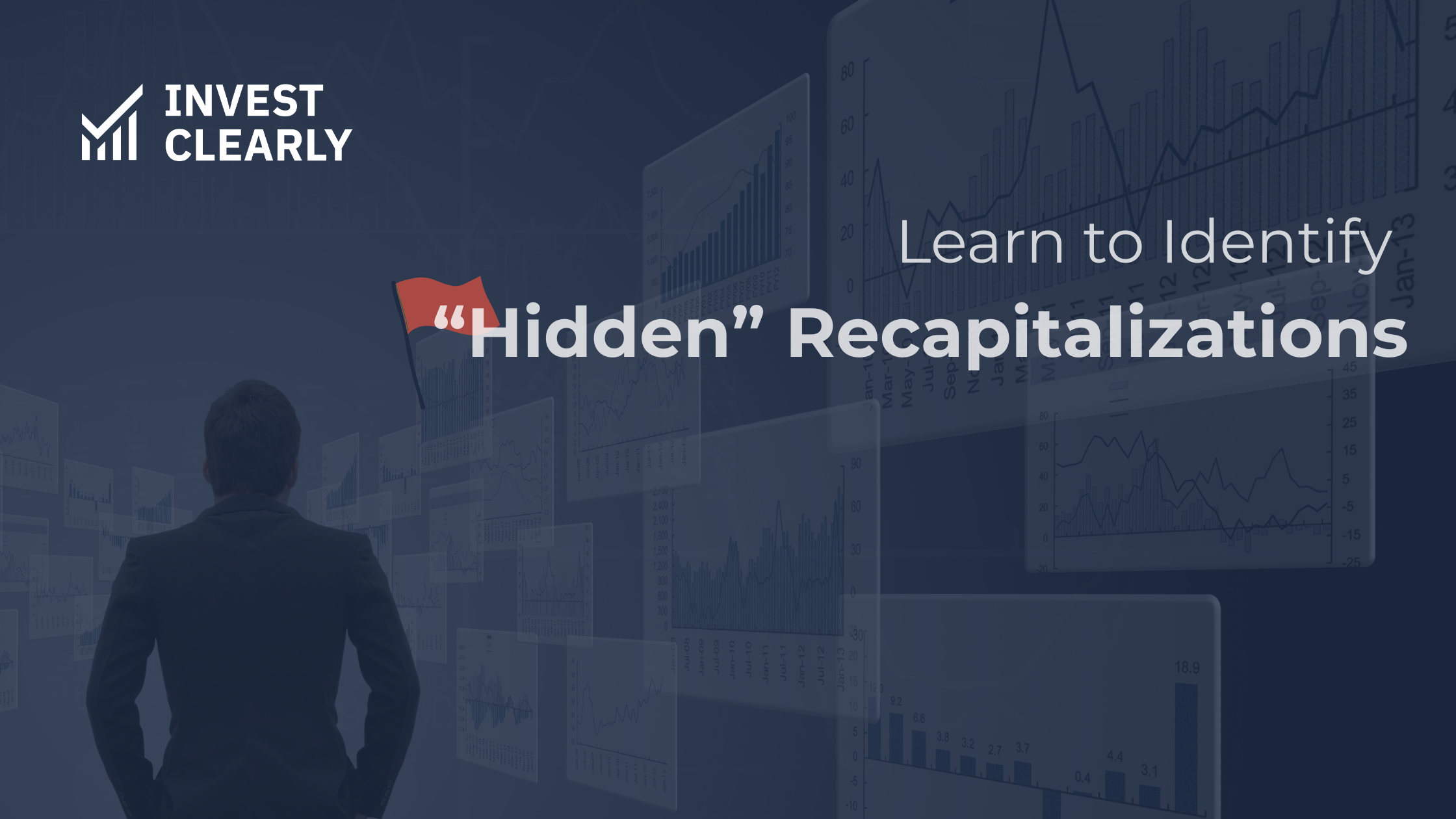
Real Estate Recapitalizations—What Passive Investors Need to Know
A recapitalization is a restructuring of a property's capital stack (the mix of debt and equity that finances an investment). While they can be legitimate business strategies, transparency can be an issue.
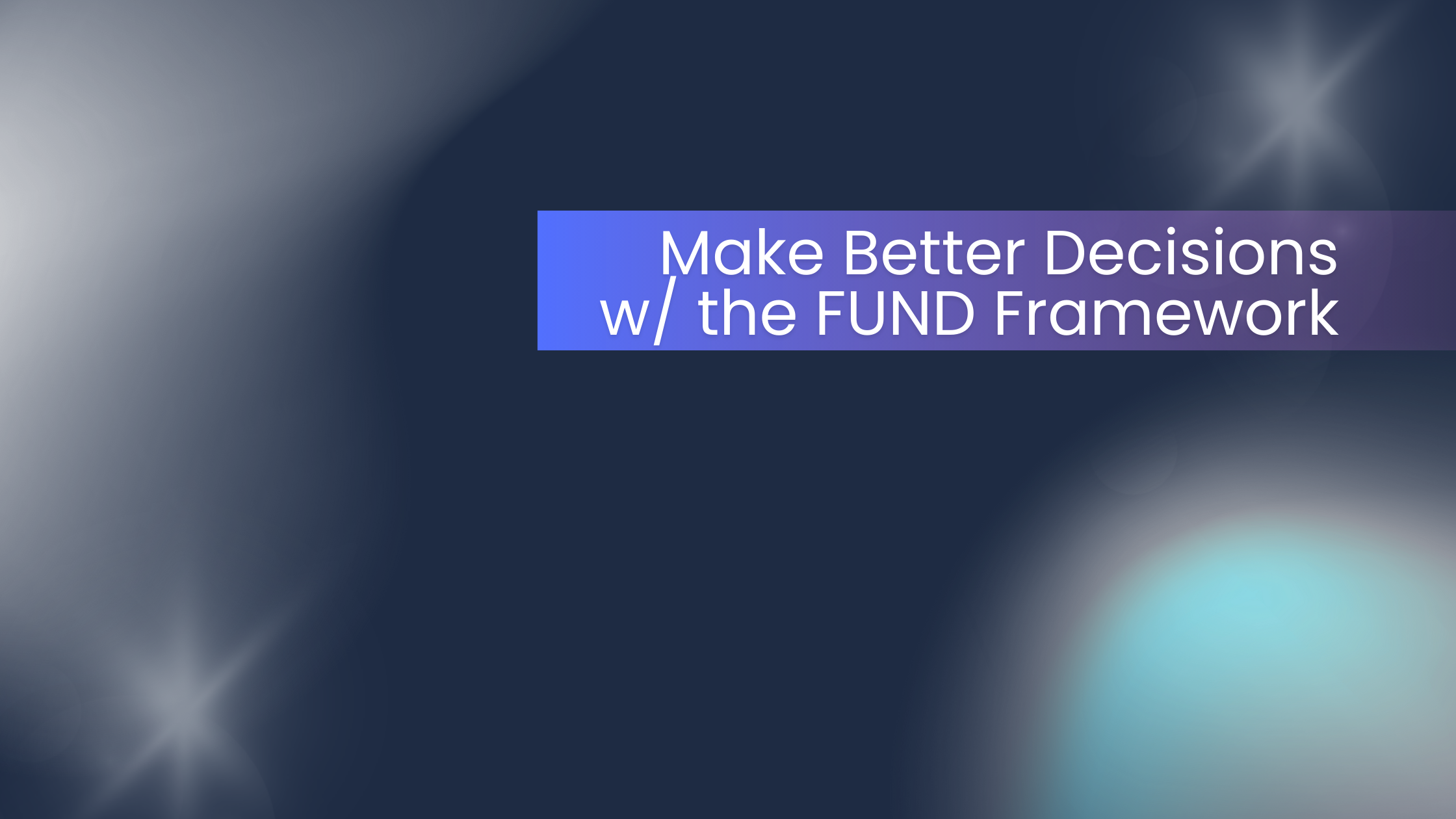
How to Evaluate a Potential Investment Using the FUND Framework
The FUND framework is a simple way to evaluate opportunities by looking at four pillars: Financials, Underlying Assets, Notable Differentiator, and Delegation of Responsibilities.
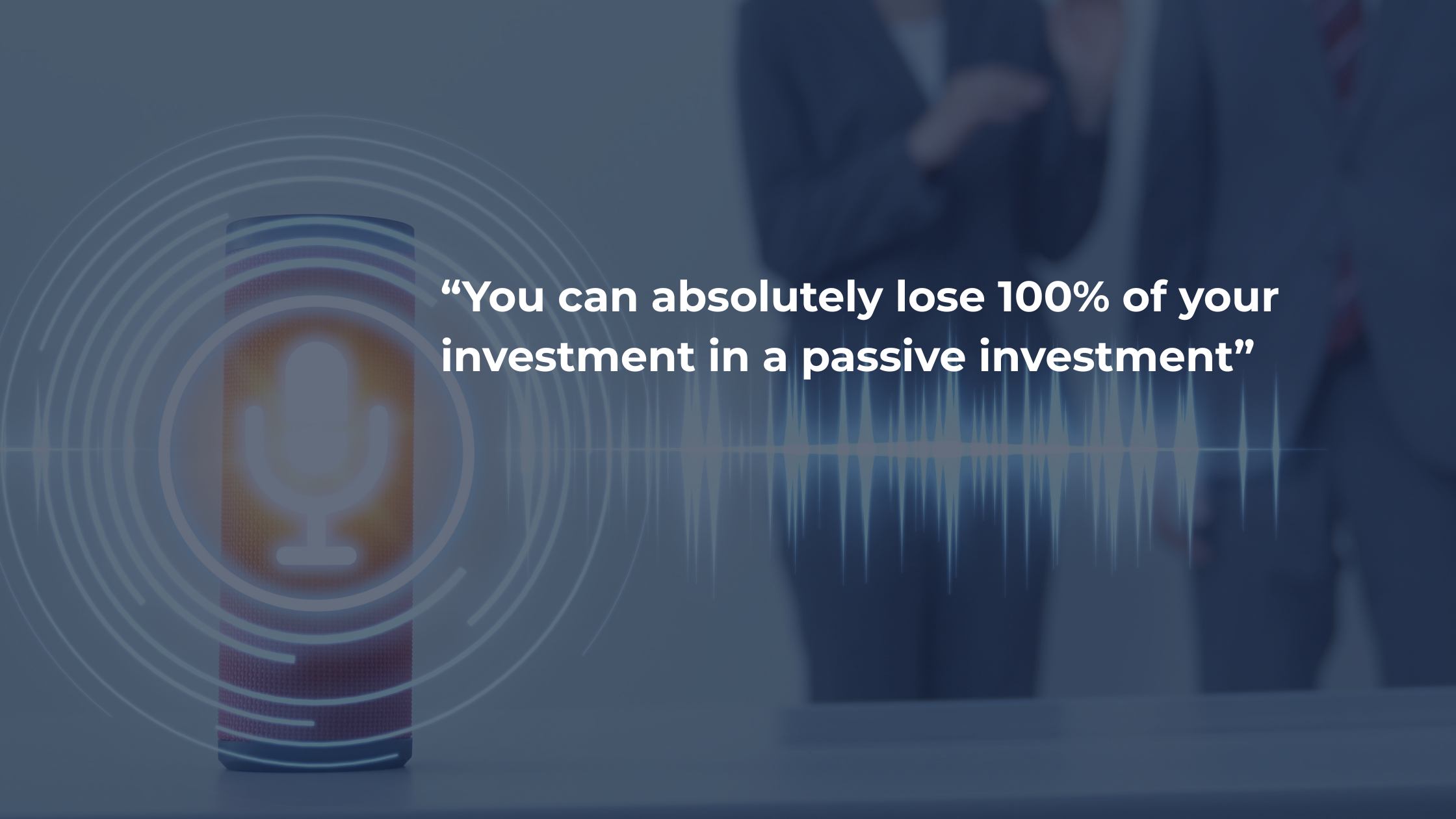
What Needs to “Die” in Passive Investing – According to Guests of The Invest Clearly Podcast
Get the answer to the closeout questions of each podcast episode: “What do you think needs to die in passive investing?” The answers are wide-ranging, from misconceptions about risk, to misleading marketing tactics, to structural issues in how deals are presented.

Passive Real Estate Investing Advice from Experienced LP Investors
Experienced LPs shared their most valuable lessons, drawn from years of investing across various asset classes and sponsor relationships.
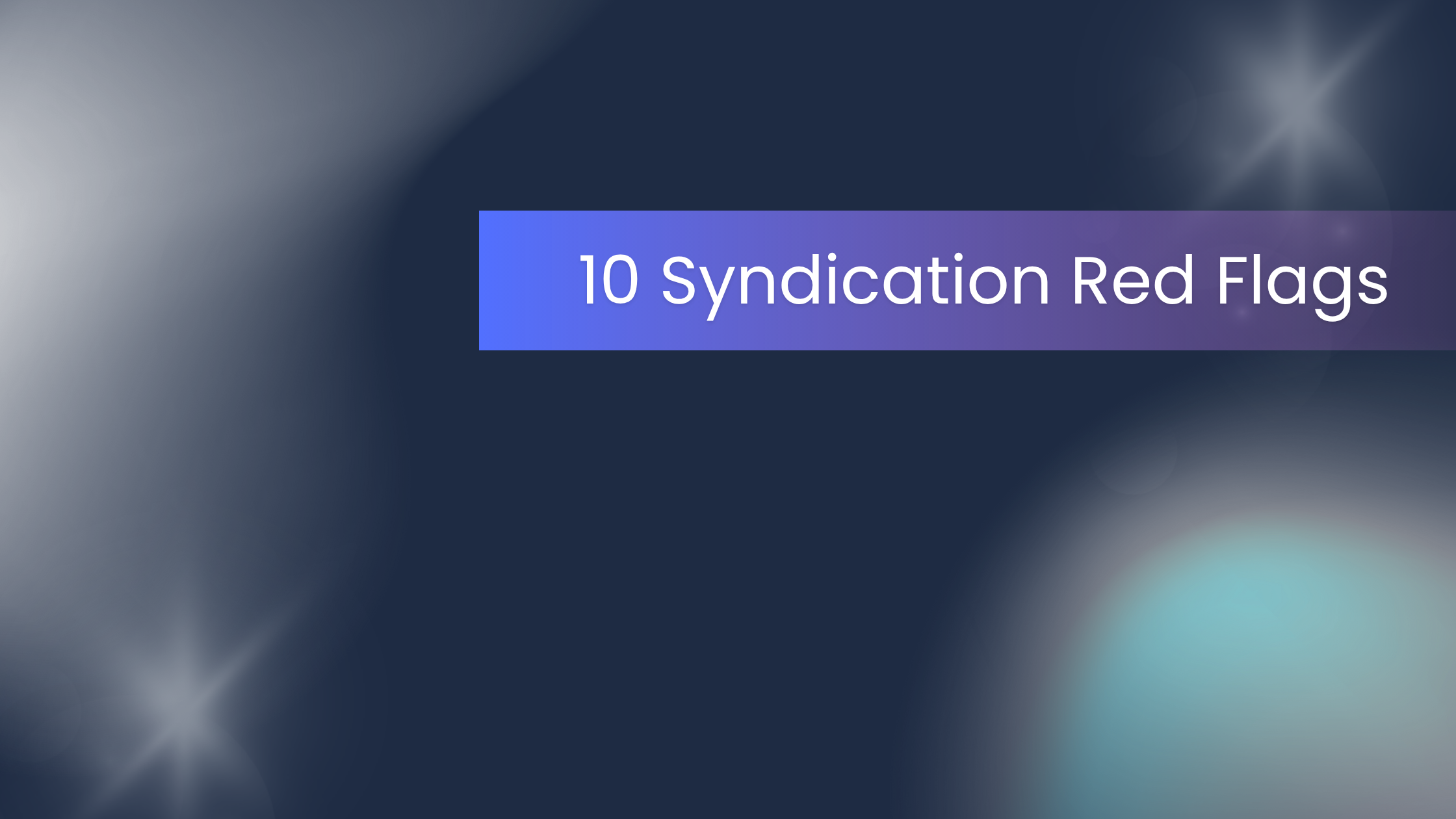
How to Spot Red Flags in Private Real Estate Deals: 10 Risks Every Investor Should Know
The SEC reported that investment scams cost Americans more than $5.7 billion in 2024, with many cases tied to private offerings (like real estate syndications) lacking oversight. Here are ten critical red flags every investor should be able to identify before committing funds to a real estate deal.

How Developers Mitigate Construction Risk to Protect Investors
Investing in multifamily development through a real estate syndication can be highly rewarding, but many passive investors wonder: What about construction risk? Delays, cost overruns, or unforeseen site conditions can feel intimidating if you’re new to the space.